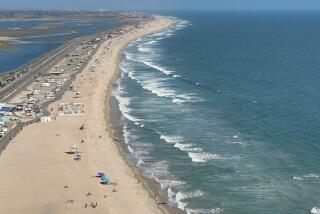Angling for a Fish
- Share via
Barge fishing beats angling your pole off the pier or casting a line in a lake if you like mackerel, the reek of bait and have a high tolerance for the high seas.
Atop a fishing barge, veteran anglers such as Rick Chavez and his 10-year-old son Ricky say, the chances of landing a fat fish are a lot better than surface fishing back on land where pickings are slim. Besides, on a platform anchored at sea, there are 360 degrees of opportunity.
So, equipped with rods, reels and a big gunnysack for the catch of the day, the Chavezes made their annual trek from Sacramento to Redondo Beach last week for opening day of the Isle of Redondo. The 534-ton vessel is the last fishing barge on the West Coast, and its annual spring season draws anyone who loves the open ocean and a lazy, hazy day of fishing.
“We love coming out here,” Rick Chavez said. “There’s a much better selection of fish to catch, and they give us live bait. It’s a great extracurricular activity that my son and I enjoy doing together.”
The Isle of Redondo is the sole survivor of a fleet of fishing barges that spanned the Pacific Coast from San Diego to Santa Monica from the 1920s until the ‘60s. Aside from sinking a hook off a pier, the barges were the cheapest way for a kid to spend the day fishing, said Pat Moore, spokesman for the state Department of Fish and Game.
*
By the mid-60s, however, the barge business had started to sink, as operating costs increased and pollution reduced the number of fish in the area, said Bob Fletcher, president of the Sportfishing Assn. of California. When the Isle opened for business in 1980, the 120-foot flat-top vessel had some competition from the Annie B. barge in San Pedro--up until last year when the Annie B. closed down.
Though many of the old barges were located near the mouth of a marina or harbor, the Isle is about 1 1/2 miles out to sea, a 20-minute ferry ride from the Redondo Beach Marina. The barge is anchored near a Navy boat sunk by the Department of Fish and Game to create an artificial reef, and the portholes and dark crevices of the sunken Pallowan attract lots of marine traffic.
For $16, a water taxi takes anglers out to the barge every hour on the hour from 7 a.m. to 4:30 p.m. and returns with passengers who have had enough fish for the day. The charge includes fishing fees and bait. The barge, operated by Redondo Beach Sportfishing, is now open Friday through Sunday. When the weather warms up in May, it will be open seven days a week and for night fishing between 6 p.m. and 4:30 a.m. in June.
“You see a lot of first time fishermen out here,” said barge master Casey Kajiyama. “It’s a great place to bring kids for the first time because they’ll usually catch at least a mackerel, which will keep them interested in fishing.”
Experienced fishmongers usually cut up the small mackerel to use as bait for bigger catch. The level boat, which has a kitchen and deck where those not interested in fishing can congregate, supplies live anchovies and sardines for bait and goes through about 30 large scoops of bait per day.
*
The sardines have worked for San Pedro fisherman Howard Wallach, who caught a 32-pound halibut aboard the barge in 1994, the largest halibut ever caught from the vessel. Last year he landed a 27-pound yellowtail. Sometimes a blue shark or bat ray, which Panorama City resident Raymond Mesina hooked Friday when the barge officially opened for the season, will bite at the bait, but deckhands ask that those variations of marine life be tossed back into the ocean.
Over the years, Kajiyama and deck hand James Caton have seen some big fish landed on the barge. One veteran angler caught a 200-pound blue shark last year while another reeled in a 180-pounder. Still, there are others who catch nothing bigger than their bait.
But the fisherman that Kajiyama remembers more than any of the others is an older gentleman whose story resembled “The Old Man and the Sea.” Much like old man, the fisherman struggled with a weighty fish for nearly five hours. In the end, the fish snapped free from the line and pulled the pole into the water.
The angler got so angry that he jumped overboard after them. By then, the pole and his fish were long gone.
Not much besides some mackerel and inedible marine life turned up on the barge last week, but regulars such as Celeste Hamilton of Long Beach say they will continue to return. Hamilton, the only regular fisherwoman on the vessel, learned how to fish aboard the Isle nine years ago.
“I really enjoy coming out here,” said Hamilton, while gutting a fish she caught on opening day. “It’s a lot of fun, so I come back as often as I can.”
More to Read
Sign up for The Wild
We’ll help you find the best places to hike, bike and run, as well as the perfect silent spots for meditation and yoga.
You may occasionally receive promotional content from the Los Angeles Times.






